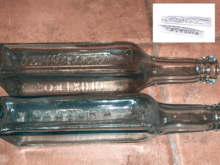The Centaur Company
The Centaur Company, founded in 1871, owned and marketed proprietary medicines, notably, the stimulant laxative Fletcher's Castoria and the ointment Centaur Liniment. The company is historically significant in that it was a driving force during the early development of mass marketing and advertising.
| Industry | Pharmeceutical |
|---|---|
| Founded | 1871 |
| Founder | Charles Henry Fletcher |
| Products | Fletcher's Castoria, Centaur Liniment |
History
In 1871, The Centaur Company was formed by Charles Henry Fletcher at 80 Varick Street, New York City to purchase the rights to and manufacture the laxative Pitcher's Castoria, renamed Fletcher's Castoria after the founder. Together with Demas Barnes and Joseph B. Rose who had purchased the formula for Centaur Liniment that same year, manufacturing began.
In 1923 Sterling Drug purchased a 1/4 interest in The Centaur Company and eventually purchased the entire company.[1]
In 1934, the Centaur Company Division of Sterling Products (later called Sterling Drug) purchased Z.B.T. products from the Crystal Corporation.
In 1984, Sterling Drug sold Centaur's raison d'être product, Fletcher's Castoria, to Mentholatum Co Inc.
The Centaur-Caldwell division of Sterling Drug also owned the marketing rights to Dr. William B. Caldwell's "Syrup Pepsin", manufactured in Monticello, Illinois, until the factory closed in 1985.

Advertising
In the 1870s, The Centaur Company began doing significant advertising to create its brands, with a primary emphasis on Castoria. Between 1870 and World War II "Children cry for Chas. H. Fletcher's Castoria" was one of the best known advertising slogans.[2][3] At the opening of the Brooklyn Bridge in 1883, Chas. H. Fletcher painted advertisements on virtually every blank wall in sight; they are quite visible in images of the opening of the bridge.[4] Castoria ads from the 1870s through 1920s are still visible today on the buildings of New York.[5][6]

Centaur was an early practitioner of the use of celebrities in mass advertising. Centaur Liniment advertising included a purported endorsement from P.T. Barnum.[7] One famous ad had the company represented by Barnum's famous circus star Jumbo, the giant elephant. Another ad featured the legendary boxer Joe Louis.[8]
In the 1920s, Centaur was one of the earliest advertisers targeting women directly.[9] "Their advertising prior to that had targeted both men and women, but here [in the 1920s] they began to advertise additionally in the new publications specifically targeted to women."[8]
There were three "Fletcher's Castoria" B-17 Flying Fortress bombers during World War II, part of the 100th Bomber Group. The first was lost, but the crew survived. The second survived the war. Its pilot was William H. Fletcher, hence its name although the pilot was not a descendant of Charles Henry Fletcher. [10] [11]
References
- New York Times, Feb 9, 1923, Page 24, col 1 ??
- "Children Cry for Pitcher's Castoria", The New York Almanac, 1888
- "Children Cry for Chas. H. Fletcher's Castoria". The New York Times. February 9, 1923. p. 24, col. 1.
- Smith, Wes (November 11, 1984). "Bridge Over Two-Bit Bay to Cost Pompano Dearly". The Miami Herald. BRWD section, p. BR.
- Pietri, E.R. "A Castoria Story". Forgotten-NY ads. Forgotten-NY. Archived from the original on December 4, 2004.
- Jump, Frank H. "Fletcher's Castoria, Chinatown, NYC - taken March, 1997". Fading Ad Campaign. Retrieved June 15, 2016.
- "Cas-car-ria". Low Country Digital Library. Retrieved 1 September 2014.
- "The Centaur Company, est 1871". 1994–2002. Archived from the original on January 5, 2005.
- "Devil-may-care 1920s found papers giving women more voice and space", By Martin Kady Journal Now, 1997, Centennial, 1897-1997, Piedmont Publishing
- "William H Fletcher, Castoria III".
- "Crash of Fletcher's Castoria".
External links
- history of the company and its advertising
- Advertisement for Dr. Caldwell's Syrup Pepsin in a 1921 newspaper: Healthy Young Womanhood, The Pittsburg Press, May 25, 1921, p. 15.